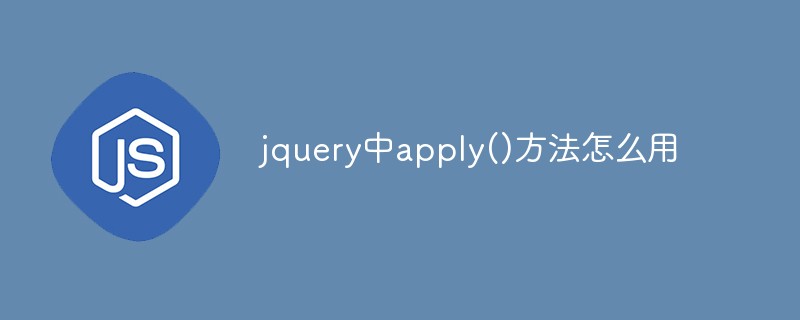This article mainly introduces you to the detailed explanation and simple examples of jQuery extend(). Friends who need it can refer to it. I hope it can help everyone.
jQuery extend() detailed explanation and simple examples
When you use jQuery, you will find that some functions in jQuery are used like this:
$.get(); $.post(); $.getJSON();
Some functions are used like this:
$('p').css(); $('ul').find('li');
Some functions are used like this:
$('li').each(callback); $.each(lis,callback);
There are two concepts involved here: tool methods and instance methods. Usually the tool methods we talk about refer to functions that can be called without instantiation, such as the first piece of code; instance methods are functions that can only be called after the object is instantiated, such as the second piece of code. Many methods in jQuery are both instance methods and tool methods, but the calling method is slightly different, such as the third piece of code. In order to explain the tool methods and instance methods in JavaScript more clearly, the following test is performed.
functionA(){
}
A.prototype.fun_p=function(){console.log("prototpye");};
A.fun_c=function(){console.log("constructor");};
var a=new A();
A.fun_p();//A.fun_p is not a function
A.fun_c();//constructor
a.fun_p();//prototpye
a.fun_c();//a.fun_c is not a functionIt can be concluded from the above test that the instance method is defined in the prototype, and the tool method is added directly in the constructor; the instance method cannot Called by the constructor, similarly, tool methods cannot be called by instances.
Of course, instance methods can not only be defined in the prototype, there are the following three definition methods:
functionA(){
this.fun_f=function(){
console.log("Iam in the constructor");
};
}
A.prototype.fun_p=function(){
console.log("Iam in the prototype");
};
var a=newA();
a.fun_f();//Iam in the constructor
a.fun_i=function(){
console.log("Iam in the instance");
};
a.fun_i();//Iam in the instance
a.fun_p();//Iam in the prototypeThese three ways The priority is: variables defined directly on the instance have a higher priority than those defined on "this", and variables defined on "this" are higher than variables defined by the prototype. That is, variables defined directly on the instance will overwrite variables defined on "this" and prototype, and variables defined on "this" will overwrite variables defined on prototype.
Let’s look at the source code of the extend() method in jQuery:
jQuery.extend = jQuery.fn.extend = function() {
var options,name, src, copy, copyIsArray, clone,
target= arguments[0] || {},
i =1,
length= arguments.length,
deep= false;
// Handle adeep copy situation
if ( typeoftarget === "boolean" ) {
deep= target;
//Skip the boolean and the target
target= arguments[ i ] || {};
i++;
}
// Handlecase when target is a string or something (possible in deep copy)
if ( typeoftarget !== "object" && !jQuery.isFunction(target) ) {
target= {};
}
// ExtendjQuery itself if only one argument is passed
if ( i ===length ) {
target= this;
i--;
}
for ( ; i< length; i++ ) {
//Only deal with non-null/undefined values
if ((options = arguments[ i ]) != null ) {
//Extend the base object
for( name in options ) {
src= target[ name ];
copy= options[ name ];
//Prevent never-ending loop
if( target === copy ) {
continue;
}
//Recurse if we're merging plain objects or arrays
if( deep && copy && ( jQuery.isPlainObject(copy) || (copyIsArray= jQuery.isArray(copy)) ) ) {
if( copyIsArray ) {
copyIsArray= false;
clone= src && jQuery.isArray(src) ? src : [];
}else {
clone= src && jQuery.isPlainObject(src) ? src : {};
}
//Never move original objects, clone them
target[name ] = jQuery.extend( deep, clone, copy );
//Don't bring in undefined values
}else if ( copy !== undefined ) {
target[name ] = copy;
}
}
}
}
// Returnthe modified object
return target;
}; (1) First, jQuery and its prototype extend( ) method is implemented using the same function.
(2) When there is only one parameter in extend(), a plug-in is added to the jQuery object. What is extended on jQuery is called a tool method. What is extended in jQuery.fn (jQuery prototype) is an instance method. Even if you extend a function with the same name on jQuery and the prototype, using a jQuery object will call the tool method. Use jQuery() Instance methods are called.
(3) When there are multiple parameters in extend(), the subsequent parameters are extended to the first parameter.
var a={};
$.extend(a,{name:"hello"},{age:10});
console.log(a);//Object{name: "hello", age: 10} (4) Shallow copy (default):
var a={};
varb={name:"hello"};
$.extend(a,b);
console.log(a);//Object{name: "hello"}
a.name="hi";
console.log(b);//Object{name: "hello"}b is not affected by A is affected by a, but if an attribute in b is an object:
var a={};
varb={name:{age:10}};
$.extend(a,b);
console.log(a.name);//Object{age: 10}
a.name.age=20;
console.log(b.name);//Object{age: 20} Since the shallow copy cannot be completed, b.name will be affected by a. At this time we Often a deep copy is desired.
Deep copy:
var a={};
varb={name:{age:10}};
$.extend(true,a,b);
console.log(a.name);//Object{age: 10}
a.name.age=20;
console.log(b.name);//Object{age: 10}b.name is not affected by a.
var a={name:{job:"Web Develop"}};
var b={name:{age:10}};
$.extend(true,a,b);
console.log(a.name);//age: 10 job: "Web Develop"//b.name没有覆盖a.name.job。
Related recommendations:
About in jQuery Summary of the use of extend()
Comparison and use of clone() and extend() in jQuery
$.extend( in jQuery )Usage example_jquery
The above is the detailed content of Detailed explanation of jQuery extend(). For more information, please follow other related articles on the PHP Chinese website!
 jquery实现多少秒后隐藏图片Apr 20, 2022 pm 05:33 PM
jquery实现多少秒后隐藏图片Apr 20, 2022 pm 05:33 PM实现方法:1、用“$("img").delay(毫秒数).fadeOut()”语句,delay()设置延迟秒数;2、用“setTimeout(function(){ $("img").hide(); },毫秒值);”语句,通过定时器来延迟。
 jquery怎么修改min-height样式Apr 20, 2022 pm 12:19 PM
jquery怎么修改min-height样式Apr 20, 2022 pm 12:19 PM修改方法:1、用css()设置新样式,语法“$(元素).css("min-height","新值")”;2、用attr(),通过设置style属性来添加新样式,语法“$(元素).attr("style","min-height:新值")”。
 axios与jquery的区别是什么Apr 20, 2022 pm 06:18 PM
axios与jquery的区别是什么Apr 20, 2022 pm 06:18 PM区别:1、axios是一个异步请求框架,用于封装底层的XMLHttpRequest,而jquery是一个JavaScript库,只是顺便封装了dom操作;2、axios是基于承诺对象的,可以用承诺对象中的方法,而jquery不基于承诺对象。
 jquery怎么在body中增加元素Apr 22, 2022 am 11:13 AM
jquery怎么在body中增加元素Apr 22, 2022 am 11:13 AM增加元素的方法:1、用append(),语法“$("body").append(新元素)”,可向body内部的末尾处增加元素;2、用prepend(),语法“$("body").prepend(新元素)”,可向body内部的开始处增加元素。
 jquery中apply()方法怎么用Apr 24, 2022 pm 05:35 PM
jquery中apply()方法怎么用Apr 24, 2022 pm 05:35 PM在jquery中,apply()方法用于改变this指向,使用另一个对象替换当前对象,是应用某一对象的一个方法,语法为“apply(thisobj,[argarray])”;参数argarray表示的是以数组的形式进行传递。
 jquery怎么删除div内所有子元素Apr 21, 2022 pm 07:08 PM
jquery怎么删除div内所有子元素Apr 21, 2022 pm 07:08 PM删除方法:1、用empty(),语法“$("div").empty();”,可删除所有子节点和内容;2、用children()和remove(),语法“$("div").children().remove();”,只删除子元素,不删除内容。
 jquery on()有几个参数Apr 21, 2022 am 11:29 AM
jquery on()有几个参数Apr 21, 2022 am 11:29 AMon()方法有4个参数:1、第一个参数不可省略,规定要从被选元素添加的一个或多个事件或命名空间;2、第二个参数可省略,规定元素的事件处理程序;3、第三个参数可省略,规定传递到函数的额外数据;4、第四个参数可省略,规定当事件发生时运行的函数。
 jquery怎么去掉只读属性Apr 20, 2022 pm 07:55 PM
jquery怎么去掉只读属性Apr 20, 2022 pm 07:55 PM去掉方法:1、用“$(selector).removeAttr("readonly")”语句删除readonly属性;2、用“$(selector).attr("readonly",false)”将readonly属性的值设置为false。


Hot AI Tools

Undresser.AI Undress
AI-powered app for creating realistic nude photos

AI Clothes Remover
Online AI tool for removing clothes from photos.

Undress AI Tool
Undress images for free

Clothoff.io
AI clothes remover

AI Hentai Generator
Generate AI Hentai for free.

Hot Article

Hot Tools

ZendStudio 13.5.1 Mac
Powerful PHP integrated development environment

Safe Exam Browser
Safe Exam Browser is a secure browser environment for taking online exams securely. This software turns any computer into a secure workstation. It controls access to any utility and prevents students from using unauthorized resources.

DVWA
Damn Vulnerable Web App (DVWA) is a PHP/MySQL web application that is very vulnerable. Its main goals are to be an aid for security professionals to test their skills and tools in a legal environment, to help web developers better understand the process of securing web applications, and to help teachers/students teach/learn in a classroom environment Web application security. The goal of DVWA is to practice some of the most common web vulnerabilities through a simple and straightforward interface, with varying degrees of difficulty. Please note that this software

SublimeText3 English version
Recommended: Win version, supports code prompts!

VSCode Windows 64-bit Download
A free and powerful IDE editor launched by Microsoft






